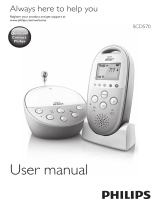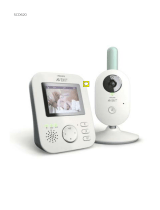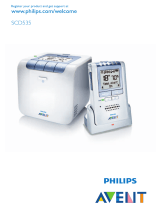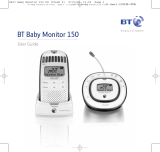
13
4
5 If the alert is off, the display shows ‘On?’. Press
the OK button to switch on the alert. If the
alert is on, the display shows ‘Off?’. Press the
OK button to switch off the alert.
• If you have set the sound alert to ‘on’, the
sound alert symbol ( q) appears on the
display of the parent unit.
7.7 Setting room temperature
range
D Note:
You can only adjust the temperature range in the
menu of the parent unit.
A baby will sleep comfortably in a room heated
to a temperature between 16°C and 20°C. This is
important, since a baby cannot regulate its body
temperature as well as an adult. A baby needs
more time to adjust to temperature changes.
If you do not set a temperature range, the baby
monitor alerts you when the temperature in your
baby’s room drops below 14°C or rises above
35°C. In this case, the backlight of the parent unit
display goes on and ‘High’ or ‘Low’ appears on
the display. To change the default minimum and
maximum temperature, follow the instructions
below.
D
Note:
The temperature of the baby’s room is shown
on the display of the parent unit when they are
linked.
1 Select ‘Temperature’ with the + and - buttons.
2
3 Select ‘Range’ with the + and - buttons.
4
5 Set the desired minimum temperature with
the + and - buttons.
6
7 Set the desired maximum temperature with
the + and - buttons.
8
• The message ‘Saved’ appears on the display.
7.5 Adjusting microphone
sensitivity
D Note:
You can only adjust the microphone sensitivity in
the menu of the parent unit.
You can set the microphone sensitivity of the
baby unit to the desired level. You can only change
the microphone sensitivity when a connection
between the baby unit and the parent unit has
been established, i.e. when the LINK light on the
parent unit lights up green continuously.
1 Select ‘Sensitivity’ with the + and - buttons.
2
3 Select the desired microphone sensitivity
level for the baby unit with the + and -
buttons. (Fig. 31)
1 Minimum sensitivity level
2 Maximum sensitivity level
4
• The message ‘Saved’ appears on the display.
D
Note:
When the microphone sensitivity of the baby unit
is set to a high level, it picks up more sounds and
therefore transmits more often. As a result, the
units consume more power and the operating
time of the battery is shorter.
7.6 Sound alert on/off
D Note:
You can only switch the sound alert on and off in
the menu of the parent unit.
This feature allows you to monitor your baby silently.
It enables you to switch off the volume on your
parent unit and still be alerted if your baby cries.
If the sound alert is switched on, the parent unit
beeps as soon as the fourth sound level light
lights up blue while the volume is switched off. In
addition, the backlight of the parent unit display
goes on and the sound alert symbol ( q
on the display.
1 Select ‘Alert settings’ with the + and - buttons.
2
3 Select ‘Sound alert’ with the + and - buttons.
ENGLISH






















